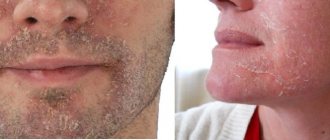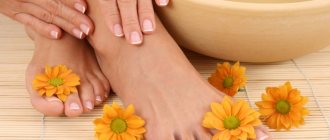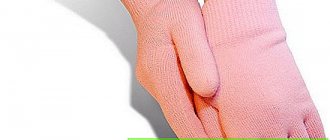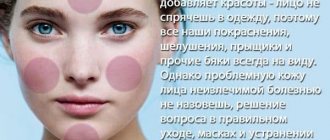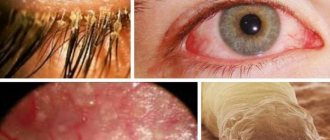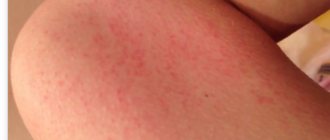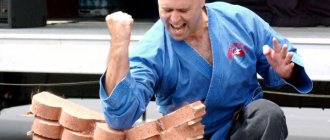A child has dry skin or flaky spots on the body: causes and possible diagnoses
Smooth, elastic, pink - these epithets usually describe children's skin. Unfortunately, this is just an ideal picture, but in reality, parents often face the fact that their baby’s skin becomes dry. Although in most cases this condition is easily explainable from a physiological point of view, there is no need to let the situation take its course. In some cases, this phenomenon is one of the symptoms of diseases, sometimes very serious ones. You should not self-medicate; it is better to contact a pediatrician, who will select a set of measures.
Signs of dry skin
A healthy child should have elastic skin of a uniform color without inflammation, spots, areas of peeling and other pathological symptoms.
Symptoms of dry skin:
- dull color;
- decreased elasticity;
- scale formation;
- the appearance of wounds, inflammations;
- crust formation.
Dehydration of the epidermis in a child is not just a cosmetic defect. Loss of moisture can cause cracks in thin skin, into which infection from the outside world can easily penetrate. Since the baby's immunity is just developing, this can lead to serious complications.
Causes of dry skin on the body
Dehydration of children's skin can be associated with external and internal factors. One of the main reasons is the structural feature:
- Very thin top layer, poorly connected to the lower layers. There is practically no fatty tissue, so the epidermis is sensitive to external factors.
- Underdevelopment of basic functions: children under a certain age do not sweat, the sebaceous glands do not work, so thermoregulation is impaired.
- On the surface of the epidermis there is a layer of lipids that are supposed to protect the skin, but sometimes the opposite happens. Microbes entering it begin to actively multiply, which, under certain circumstances, provokes an inflammatory process and dryness.
In addition to physiology, the condition of the baby’s skin is influenced by external factors:
- Dry indoor air.
- Using unsuitable bathing and grooming products. Some children even react to expensive creams, shampoos and even herbal infusions.
- Bathing in hot water (temperature above 38 degrees).
- Change of seasons. It has been noticed that in late autumn and early spring the skin condition worsens even in adults. This is due to changes in humidity and temperature indoors and outdoors.
- Staying in the sun. In the summer, children spend a lot of time outside; parents often forget to protect their skin with special creams, as a result of which it dries out.
- Walking in windy or frosty weather can cause exposed areas to peel.
- Washing with soap too often, staying in a full diaper or dirty clothes for a long time.
- A sharp change in temperature - going outside in winter without applying protective cream.
Dryness and flaking may be a sign of diseases:
- atopic dermatitis or allergies to food, household chemicals, pets;
- pathologies of the thyroid gland;
- infection with worms;
- bowel dysfunction;
- Ichthyosis is a serious genetic disorder that causes the skin to become covered with scales.
In children, the skin becomes dry when there is a high temperature or when there is general dehydration caused by overheating, vomiting or diarrhea.
Why does the skin peel off on the feet of a teenager?
Many people complain that the skin on their feet is peeling.
Peeling is influenced by various factors, both external (wearing uncomfortable shoes) and internal (lack of vitamins or diseases of the digestive tract). Skin peeling can be painless, causing only cosmetic discomfort. In other cases, peeling is accompanied by itching, pain and cracks in the heels or between the toes.
Causes of pathology
When an unpleasant symptom appears, people wonder why the skin on the soles of their feet peels off. The main factor contributing to exfoliation in an adult or child is dry skin of the feet. The dead layer of the epidermis gradually peels off.
The following reasons are identified that influence skin separation:
- Inconvenient, closed and tight shoes impair the breathing of the skin. Oxygen practically does not reach the feet, which causes severe peeling.
- Lack of vitamins and mineral elements - this factor causes skin peeling not only on the feet, but also on other parts of the body. At the same time, the condition of people's hair and nails deteriorates. Among dermatologists, it is generally accepted that peeling is caused by a lack of vitamins A and E.
- Poor skin hydration - in summer and hot weather, the skin becomes very dry, and the body feels a lack of clean water. A similar situation is observed during the heating season.
- Fungal skin diseases often lead to peeling of the feet. But in this case, a sharp and unpleasant odor comes from the feet, the feet are very itchy. Fungi are usually infected by people who visit public places that involve walking barefoot. For example: baths, saunas, swimming pools.
- Exposure of the skin to low or high temperatures, extreme and sudden changes in ambient temperature. For example: in case of frostbite or severe burn.
- Wearing socks, stockings or tights made from synthetic materials. Access to oxygen becomes difficult, the skin dries out greatly.
- Peeling of the feet is also affected by prolonged stressful situations and being in a constant tense emotional state.
Skin peeling can be caused by poorly selected cosmetics, regular exposure to chlorinated water, and disturbances in the digestive system.
Skin diseases (dermatitis, eczema or psoriasis) also lead to severe detachment of the epidermis.
Why does the skin peel off in children?
The child’s epidermis also peels off on the soles of his feet, sometimes it even peels off in whole pieces.
The reasons why the skin of the legs peels off in young children are similar to the factors that cause peeling in adults.
But babies still often develop dermatitis, leading to separation of the upper layer of the epidermis. Sometimes the skin peels as a result of an allergy to synthetic materials, skin care products, etc.
Children usually do not require specific treatment. It is necessary to normalize nutrition, introduce more fresh fruits, vegetables, fish, dairy products, dietary meats (rabbit, turkey or nutria). If necessary, you should give your child a vitamin complex.
To additionally moisturize the skin of a child’s feet, you should choose creams based on urea or lactic acid. As additional remedies, doctors recommend lubricating the feet with aloe juice, sea buckthorn oil, or a liquid form of vitamin A.
Why does the skin peel among older children?
The skin on the soles of the feet can also peel off in teenagers. The defect develops for the same reasons as in adults. A dermatologist will examine a young patient and prescribe a course of therapy.
If we are talking about fungal diseases or peeling caused by microbes, then the child requires treatment.
What to do during pregnancy
Women expecting a baby try to use medications as little as possible to minimize the impact on the fetus. You should not self-medicate; be sure to consult your doctor.
Dermatologists recommend choosing creams that do not contain retinol. Salicylic ointment is considered the most suitable.
How doctors treat peeling skin
Initially, the doctor examines the feet and asks about the medical history. If necessary, general tests are taken from the patient; if foot fungus is suspected, scrapings are taken from the feet.
After the test results, the dermatologist diagnoses the disease, identifies the causes of peeling and prescribes treatment:
- If the skin peels off due to a fungus, then doctors prescribe local medications in the form of creams, gels or ointments: Lamisil, Exoderil, Nystatin, Ketoconazole.
- For severe itching or burning, it is recommended to take antihistamines. Therapy is carried out with the help of Zodak, Suprastin or Zyrtec.
- If peeling is caused by dermatitis, eczema, psoriasis or other skin diseases, then steroid medications must be used. The most common drug: Prednisolone.
- Local anti-inflammatory ointments include Bepanten or Fenistil. You can also use corticosteroid drugs: Lokoid, Avanten. Ointments will relieve itching and alleviate the patient's condition.
- For severe fungal infections of the feet, you should take a course of tablets: Itraconazole or Lamisil.
- Baths with potassium permanganate will help alleviate the condition of patients suffering from fungal diseases. They disinfect the skin and help fight fungi. Heat the water to 40 degrees, dilute potassium permanganate in it until the solution becomes dark in color. Keep your feet in the bath for up to 20 minutes.
Dry your feet, apply medications and put on cotton socks.
Treatment at home
In addition to traditional medicine, you can use cosmetic methods to soften your skin without leaving your home. They are suitable for both children and adults.
Ointments and compresses moisturize and nourish the skin of the feet of a child and an adult:
- Prepare two yolks, add a few tablespoons of warm oil (sunflower or olive) to them. Whisk the mixture well, apply to clean feet, wrapping them in plastic wrap. Put on socks, walk for an hour, then wash off.
- Take any foot cream, mix three spoons with 50 milliliters of chamomile infusion. Next, make a solution from starch: dilute two tablespoons of powder with water to make sour cream. Mix both solutions and spread it on your feet. Wrap your feet in film and put socks on top. Wash your feet well after half an hour.
- Prepare a few spoons of rich body cream, add a little freshly squeezed carrot or beet juice to it (you can even mix both juices). Apply the resulting mixture to your feet and wash them after 30 to 40 minutes.
For foot fungus, you can use proven folk remedies: baths with iodine, soda, vinegar, salt.
Prevention
Regular care of the skin of an adult's feet can help avoid problems associated with dry feet.
The following preventive measures will help improve the condition of the skin:
- Before going to bed, always wash your feet, lubricating them with a special foot cream;
- choose shoes from high-quality materials, and socks from breathable fabrics (cotton or linen);
- take a vitamin complex several times a year, it will improve the condition of the body as a whole;
- a couple of times a week it is worth making softening baths from decoctions of medicinal herbs: chamomile, calendula, or with the addition of baking soda or lemon;
- Maintain a water regime; an adult should drink from one and a half to two liters of clean water every day.
- Include foods containing vitamins A and E in your diet. Diversify the menu with fish, seafood, carrots, broccoli, nuts, and unrefined vegetable oils.
- Do leg exercises regularly to improve blood flow. Simply raise your legs above body level; to do this, lie on your back. Shake your limbs for 2 - 3 minutes.
Conclusion
Peeling of the skin on the soles of the feet in children and adults is an unpleasant defect. Sometimes the separation of the upper layers of the epidermis is not accompanied by additional symptoms and goes unnoticed. But in some cases, cracks form on the heels or toes.
Doctors warn! Shocking statistics - it has been established that more than 74% of skin diseases are a sign of parasite infection (Accarida, Giardia, Toxocara).
Worms cause enormous harm to the body, and the first to suffer is our immune system, which should protect the body from various diseases.
The head of the Institute of Parasitology shared the secret of how to quickly get rid of them and cleanse your skin, it turns out that’s enough. Read more .
The skin of the feet itches and burns, and there may be an unpleasant and pungent odor. In medicine, there are various reasons why the skin of the feet (heels or toes) peels off in a child or adult. If a defect appears, you should consult a dermatologist in order to diagnose the disease and undergo a course of treatment.
Skin diseases (dermatitis, eczema or psoriasis) also lead to severe detachment of the epidermis.
The skin on the feet of a child peels off - possible causes and treatment features
In the modern world, few people pay proper attention to their own health. And it's actually very sad. Even the slightest deviations from the norm can lead to irreversible processes.
Many people today complain of discomfort and disruption of the skin around the feet. Often this scourge also affects children. The skin on the legs may peel off in chunks.
Why does this happen? What to do if the skin on your child’s feet peels off? Let's look at the main causes of this problem and ways to solve them.
Source: https://clearderma.ru/interesno/pochemu-oblazit-kozha-na-stupnyah-nog-u-podrostka
How to help your child
When parents notice that their baby’s skin has become dry, the first thing they need to do is eliminate possible provoking factors:
- humidify the air in the room;
- give a drink;
- treat with an emollient.
Further actions depend on the location of the dry area and the extent of the damage.
Self-treatment is possible only if the dryness has occurred recently, does not cause discomfort and is not accompanied by inflammation and high temperature.
Peeling on the butt
Most often, children under one year of age have peeling buttocks. Noticing this, the mother should:
- remove the diaper and forget about it until the skin becomes normal;
- treat the skin with baby cream, oil or Bepanten (powder should not be used);
- change diapers as soon as the baby goes to the toilet;
- “holop” if the temperature allows.
Dry feet and hands
To prevent the disease from starting, you need to:
- wash your feet with soap;
- wipe dry;
- lubricate with baby cream and put on cotton socks.
Shoes should be replaced with open ones, and in winter they should be insulated with natural fur; the child should wear cotton tights (socks).
If the dryness does not go away, and cracks and inflammation appear, you need to take the child to a dermatologist. Dry skin on a child’s hands can be softened with special baby creams, but if they do not help, you need to consult a doctor. This symptom is inherent in many diseases; only a doctor can identify them and prescribe treatment.
Face and head
In newborns, you can often observe dry skin on the face, these are remnants of vernix lubrication. The resulting scales cannot be removed; they will disappear on their own in a few days.
The skin on the feet of a child peels off - possible causes and treatment features
In the modern world, few people pay proper attention to their own health. And it's actually very sad. Even the slightest deviations from the norm can lead to irreversible processes.
Many people today complain of discomfort and disruption of the skin around the feet. Often this scourge also affects children. The skin on the legs may peel off in chunks.
Why does this happen? What to do if the skin on your child’s feet peels off? Let's look at the main causes of this problem and ways to solve them.
What can cause it?
Why might a child's fingers peel off? There are a number of factors that provoke dryness and flaking, otherwise desquamation of the skin on the legs.
Here are just some of the possible reasons:
- Lack of hydration of the epidermis. This can lead to dry skin. Peeling is often observed during the hot season. This is due to completely natural reasons: the body experiences a water shortage. Drying of the epidermis is often observed in winter. Skin moisture can be seriously reduced due to dry air in a room with heating devices.
- Wearing poor quality or uncomfortable shoes. Skin breathing is disrupted, which can lead to peeling and dryness.
- Skin may become peeling as a result of wearing synthetic socks or tights. The breathing process of the skin is disrupted, which negatively affects the condition of the feet. Synthetic materials cause peeling of the epidermis.
- Exposure to harmful fungi is one of the most common causes of flaky skin on the legs. Associated symptoms are severe itching and an unpleasant odor. Most often, those who have to visit public pools and baths encounter fungal diseases. When staying in such establishments, it is better to wear flip-flops or flip-flops.
- Lack of vitamins and minerals. This process occurs especially actively if it is accompanied by serious chronic diseases or weak immunity. Peeling of the skin in this case can be observed not only on the feet, but also on other parts of the body. These manifestations may also be accompanied by brittle nails and hair loss. Typically, peeling of the skin occurs in case of a lack of vitamins A and E. They are involved in the processes of skin regeneration.
- Chlorinated water: Long-term exposure to chlorinated and hard water can lead to peeling of the epidermis.
- Ultraviolet radiation: with prolonged exposure to the sun, cases of burns are often observed, which cause dryness and flaking of the skin.
- Poor nutrition and gastrointestinal dysfunction.
- Stress, overwork, overexertion.
Consequences
This issue deserves special attention. Why do my toes peel off? The causes of peeling can be different.
Most adults today experience this phenomenon, but there are also cases of peeling skin on the legs of children.
This problem should be treated with special attention, because if not properly treated, it can lead to large cracks in the heels and cause significant discomfort when walking.
What do you need to know about her? Why does the skin on my feet and toes peel? The skin on the heels is completely renewed in 3-4 weeks.
This process is that the cells of the lower layer of the epidermis divide and move into the upper layers, which then fall off. If the regeneration process proceeds normally, the skin does not peel off.
The epidermis on the heels is rougher, so often the process of cell renewal ends with the appearance of a dead layer. It quickly thickens, begins to peel and crack.
What to do if the skin on your child’s toes peels off? Treatment must include healing baths and the use of special creams. If you regularly carry out such procedures, your heels will remain smooth for a long time.
Diagnostic methods
Why does the skin on my child’s feet peel off? Only a qualified dermatologist can accurately determine the causes of the problem. To do this, it is necessary to conduct a thorough visual inspection, as well as take some tests. Once the cause is determined, therapy can begin.
Treatment methods
Let's look at this in more detail. What should you do if your child has peeling skin on his feet? Once the problem is accurately diagnosed, the dermatologist can prescribe treatment. As a rule, in this case we are talking about complex therapy.
If there are signs of peeling, the following procedures may be prescribed:
- Foot baths with sea or table salt. You need to dilute one tablespoon of salt per liter of water. The exfoliated epidermis must be cleaned off using a special grater or pumice. Of course, for children's feet this procedure should be especially gentle. After performing this procedure, it is advisable to lubricate your feet with a special foot cream.
- A good remedy for peeling foot skin is laundry soap. Simply rub your feet with it and leave it until the morning, wearing socks made from natural materials. After feet, rinse with warm water and moisturize with cream.
- Taking vitamins A, B, E, D. A weakened body also requires selenium, zinc and magnesium.
- Proper diet. You need to add fruits, vegetables, sea oily fish and dairy products to your diet.
- If a doctor diagnoses a fungal infection, then to combat it it is necessary to use one of the following medicines: “Lamisil”, “Exoderil”, “Microspor”, “Kanizon”, “Loceril”. These medications must be used strictly as prescribed by your doctor.
Prevention measures
What do they include? If a child has peeling skin on his feet, there may be various reasons.
However, if you follow a few simple rules, you can easily get rid of this problem once and for all:
- Teach your baby to wash his feet every day before bed and lubricate them with moisturizer.
- Every other day, try to take warm foot baths with medicinal decoctions and infusions. Baths with soda or lemon juice have a good effect. The duration of the procedure should be at least 20 minutes. Softened and steamed feet must be processed, removing the lagging layer of epidermis.
- Choose your shoes carefully. Do not buy shoes that are too tight or narrow.
- Wear your child socks and tights made from natural materials (wool or cotton).
- Stay hydrated. Make sure your child drinks more water, especially during the hot season.
- Provide your child with proper nutrition. It’s not just that the skin on a child’s feet peels off. The reasons may lie in a poor diet. Make sure your food is rich in vitamins and minerals.
Avitaminosis
Why does the skin on my child’s feet peel off? The first and most obvious explanation is a lack of vitamins. This is especially common during the cold season. The skin begins to peel off on the face, arms and legs. These are obvious signs of a lack of vitamins A and E. This reason is one of the most harmless.
After all, to deal with it, it’s enough to simply fill the vitamin deficiency. Enrich your child's diet with foods rich in vitamin A. These include tomatoes, carrots, parsley, green peas, and pumpkin. Also, for skin diseases, both children and adults need vitamin E, which is found in butter, cheese, barley and corn.
The easiest way would be to take a course of special vitamin complexes.
You should not diagnose your child based on your own conclusions. Perhaps the reason why the skin on the baby’s feet peels off is completely different. Never self-medicate.
Impact of temperatures
During the cold season, the skin on the toes may peel off as a result of frostbite. After all, children often walk in the cold streets “until they’re blue in the face.” They do not feel at all that their feet are wet and cold. First of all, parents should assess the degree of frostbite. The child may need medical attention.
Under no circumstances should you rub the affected areas with snow: there may be microcracks in the skin through which infection can enter the body. Try warming your baby's limbs in warm water, gradually increasing its temperature. With minor frostbite, the skin should turn pink and begin to tingle.
To quickly restore the skin, experts recommend lubricating the affected area with Panthenol.
Peeling toes
The skin on your legs may peel off gradually. It usually starts with itching. At the same time, signs of destruction of the skin as such are not yet noticeable. The child may begin to scratch the skin. The areas of greatest concern are the areas between the toes. They may develop serious blisters that will later peel off.
There are also cases where peeling of the skin on the fingers goes away without symptoms of itching. Nothing bothers the baby, and parents do not notice the problem. However, peeling clearly indicates the presence of some kind of functional disorder.
If the disease is not treated promptly, the recovery process can be significantly delayed.
Why does my child have peeling skin on his feet? The causes and treatment should be determined by a doctor. Often this symptom occurs due to a fungal infection. To avoid this problem, teach your child to follow the rules of personal hygiene. The child should not use other people's towels and shoes.
Treatment of foot fungus is a rather complex process that should be carried out under the supervision of a dermatologist. To determine the pathogen, it is necessary to undergo tests. If the skin peels off in winter, it is necessary to provide it with “breathing”. It is better if the baby walks barefoot or in slippers at home.
Consequences of taking antibiotics
The skin on a child’s feet often peels off as a result of taking antibacterial drugs. One of the side effects of treatment is such dermatitis. Children tolerate therapy worse than adult patients.
Other reasons
What can cause a symptom such as peeling skin on the legs and fingers? Perhaps the problem lies in problems with the gastrointestinal tract. Often a similar symptom occurs with helminthic infestation.
Stress and overexertion can also lead to dermatitis. Allergic reactions should not be ruled out. Just think about what has changed recently in your diet or environment.
Only a qualified doctor can determine the exact cause of peeling skin.
Duration of treatment
Many parents are interested in how long it takes to combat desquamation. The duration of treatment will also depend on whether the child does not scratch the damaged areas.
Also, the recovery time for the skin depends on the location of the lesion. The feet are directly involved in walking, and constant activity does not contribute to a speedy recovery.
So be prepared for the treatment process to take quite a long time.
Drug therapy
If parents humidify the air in the room, give plenty of water, feed the baby healthy foods and use moisturizers, but the skin still remains dry, you need to contact your pediatrician. A visit to him is also necessary for the following symptoms:
- rash;
- heat;
- itching;
- deterioration of health;
- too pale skin.
To find out the cause of this condition, the doctor examines the baby, talks with the mother about nutrition and caring for him.
If necessary, a blood test is prescribed or skin scrapings are taken. In severe cases, the child is treated by a dermatologist. To get rid of excessive dryness, medications are used that are selected by the attending physician.
The most commonly used products for external use are:
- Lotions that contain urea, for example, Excipial M. The concentration of the active substance should not exceed 4%.
- Panthenol, La-Cri cream or Bepanten ointment - soften and accelerate the healing of cracks and wounds.
- Soothing ointments with glucocorticosteroids: Beloderm, Fucidin, Elokom, Lokoid. These drugs eliminate inflammation, itching, and swelling.
- Traumeel-gel. The product soothes inflamed skin.
- Iricar is a cream to eliminate itching.
- Aconite, Sulfur - drugs for the treatment of flaky spots on the skin caused by autoimmune diseases.
- Sorbents - Smecta, Enterosgel. The drugs are prescribed to cleanse the child’s body of toxic substances.
- Antihistamines (Suprastin, Claritin, Allerzin) are rarely prescribed, since they additionally dry out the baby’s skin and mucous membranes.
- Means for normalizing digestion - Plantex, Linex, Bifiform.
- Complexes with vitamins A, PP, E, fish oil.
- Sedatives: Notta, Kaprizulya, Hare.
The dosage and duration of use of medications is selected for each child individually.
Why does my child's skin peel?
If a child’s skin is peeling, it is advisable to consult a pediatrician at the first symptoms of this condition, because as soon as he makes an accurate diagnosis and prescribes effective treatment. There are many reasons for such peeling. Let us highlight those that are most often encountered in medical practice:
- improper skin care;
- adaptation of the epidermis to new conditions;
- incorrectly selected hygiene products;
- influence of the external environment;
- dry indoor air;
- allergic reaction to food.
Improper skin care. This factor quite often causes peeling of the skin in a child. Some parents bathe their baby in baths, adding a solution of potassium permanganate or other products with drying properties to the water. Therefore, it is best to bathe the baby in soft water and only with the addition of special baby soap or foam. Make sure that the water is not too hot (no more than 37ºC) to avoid irritation of the baby's skin. We recommend adding decoctions and infusions of medicinal preparations to the baby’s bathing water, which prevent the appearance of peeling and eliminate existing ones. These herbs include sage, string, chamomile.
Adaptation of the epidermis to new conditions is one of the most common causes of peeling skin in a child. Doctors call this process absolutely normal and natural. All that is required of you is to observe the baby’s condition - if there is no redness on the skin, the child is calm, then there is no reason to worry. You can simply lubricate the skin in flaky areas with a special moisturizing baby cream. Over time, the problem will disappear on its own.
Influence of the external environment. Another answer to the question of why a child’s skin peels lies in the impact of the environment on it. For example, in summer, peeling of the epidermis is a reaction to wind and sun, and in winter, to cold. To protect your baby's delicate skin in the summer, before going for a walk, lubricate it with a cream that protects against ultraviolet rays. During the cold season, try to leave as little skin exposed as possible and make sure your child does not spend too much time in the cold. However, we do not recommend applying moisturizer before going outside.
Dry indoor air. The child's skin peels due to too dry air in the house. This is especially noticeable during the heating season. In this case, you need to increase the humidity level in the room - use special air humidifiers and spray water.
Allergic reaction to food. In many cases, the child’s skin peels due to a food allergic reaction. This condition is often observed with mixed feeding and improper introduction of complementary foods to the infant. Therefore, before including any product in your baby’s diet, first consult with your pediatrician. If peeling and irritation of the skin appears immediately after consuming a new complementary food, you must immediately stop giving it to your baby.
Treatment with folk remedies
You can soothe your baby’s delicate skin using alternative, grandmotherly methods:
- lotions made from raw potatoes, grated;
- baths with decoctions of chamomile, rose petals, mint, lavender;
- moisturizing with vegetable oil mixed with geranium oil;
- an infusion of honey and Kalanchoe juice (in equal parts), kept in the refrigerator for 7-10 days, is used to treat affected areas;
- Lycopodium pollen powder will speed up the healing of inflamed skin.
Although the effectiveness of folk remedies has been proven for centuries, you should not use them without consulting a pediatrician. Many herbs and foods cause allergies in children and can complicate the course of the disease.
Prohibited actions
If a child has dry or prone to dry and irritated skin, parents need to remember what not to do:
- dress the child in clothes made of synthetics or coarse fabrics;
- bathe him every day with foaming, strong-smelling products;
- turn on the heater or air conditioner in the apartment in winter;
- overheat the child by dressing him in excessively warm clothes;
- leave in a filled diaper for a long time;
- allow long walks in hot weather, sunbathing.
Is it possible to prevent dry skin?
Oddly enough, in most cases, it is the parents who are to blame for the fact that the child has skin problems.
Lack of time or excessive care leads to the fact that the delicate dermis lacks moisture (inside or outside) and it begins to peel and crack. To avoid such difficulties, a little is enough:
- wipe the floors and furniture in the room every day, ventilate it several times a day;
- install an air humidifier in the apartment, the humidity should not be less than 50%;
- dress the child only in clothes made from natural fabrics;
- if possible, do not use diapers so that the butt can breathe more;
- Make sure your child drinks more water, compotes or weakly brewed tea. It is better to reduce juices (not natural), carbonated sweet drinks to a minimum;
- use soft powders without sulfates for washing children's clothes;
- change bed linen regularly;
- bathe in warm water, use soap, gels and shampoos no more than 2 times a week;
- walk in the fresh air for at least 2 hours every day;
- Don’t forget to smear your nose and cheeks with cream in the cold.
Why does the skin peel off on a child’s feet and how to avoid it
Dermatitis
Skin peeling off on a child’s feet and in the folds around the toes is a problem that appears in newborns and adolescents. Children's dermis is susceptible to any influences that lead to unpleasant sensations.
Causes of peeling skin in children
Reasons why the skin on a child’s feet peels:
- fungal infections;
- allergies;
- diabetes;
- diseases of the endocrine system;
- lack of humidity in the room;
- poor quality shoes;
- cosmetic products not intended for children's epidermis;
- unbalanced diet;
- excessive sweating in warm shoes, and the feet become peeling;
- stressful situations;
- the use of water containing chlorine (the dermis on the feet begins to peel off in children visiting the pool).
The hands and soles of the feet peel due to an imbalance in the body or a dermatological disease. This symptom is the primary sign of the disease. Do not ignore discomfort in the body - immediately contact a pediatric dermatologist.
Diagnostics
If there is a feeling of discomfort on your legs, the dermis peels off and dries, consult a pediatrician. The specialist will prescribe tests, conduct diagnostics and determine the reason why the child’s skin began to peel off.
For a fungal infection, the doctor will prescribe therapy with tablets and creams with an antimycotic effect. Skin areas affected by the fungus are treated with Exoderil or Exifin. The therapy is applicable to enterovirus. It is recommended to take a course of multivitamins.
The child takes tests to detect blood sugar. Children whose dermis peels off on their heels and palms at the same time will have to undergo this procedure. If the sugar content is high, the infant or adolescent is prescribed a detailed diagnosis aimed at excluding the development of diabetes.
Diabetes treatment is comprehensive. Patients will have to take additional medications throughout their lives. Diabetes is not cured, but subsides for a while, perhaps even for years.
If the cause of skin damage is hidden in an allergic reaction, an analysis is done to identify the allergen and eliminate its effect on the body. Drugs that relieve allergy symptoms - Fenistil or Zyrtec - will help your child get rid of itching. They are prescribed by the attending physician.
In other cases, it is possible to cope with the disease at home. Review your child's diet, make it balanced and healthy. Walking in the fresh air will help. Buy him comfortable shoes made from quality materials. Take a course of vitamins and minerals that strengthen your immune system.
To avoid further problems with the limbs, regularly carry out caring procedures:
- Before going to bed at night, take a salt bath every day for 20 minutes;
- add various essential oils to the water to relieve itching, soothe and help you sleep;
- after the bath, clean your feet with pumice stone, lubricate with cream and put on socks;
- During the day, it is better for the baby to run barefoot, if the temperature of the apartment allows.
Medication
The reason for peeling lies in the lack of vitamins. This happens in winter, spring or after an illness. The body has exhausted its vitamin resources and they urgently need replenishment. Contact your doctor, he will help you determine the missing elements. Skin problems arise when there is a lack of vitamins A and E. Purchase a vitamin complex that is appropriate for the child’s age.
The skin on your baby's fingers may peel off due to a fungal disease. At risk are children who visit a public swimming pool, run barefoot on the street and play with animals. In addition to peeling, itching will appear in areas of fungal infection.
At the first signs of illness, you should consult a doctor. Don't ignore the symptoms. The specialist will prescribe ointments - Terbizil or Exoderil. Self-medication leads to aggravation of the situation.
Subsequently, the nail will fester, making home treatment impossible, and hospitalization will be required.
Traditional methods
Traditional medicine recipes will help if your child’s feet are peeling. It effectively fights the disease that occurs on the leg. Using folk remedies will moisturize the pads of your heels, and the disease will pass unnoticed.
The suggested recipes will help if the baby’s skin begins to peel off:
- Take 100 ml castor oil and heat it in a water bath. If desired, you can use olive or any other. Mix the heated oil with a whisk with two yolks. Apply the mixture to the damaged surface, wrap it in polyethylene, and put a wool sock on top. Leave for 40 minutes, then rinse with running water and laundry soap.
- Prepare a chamomile decoction, mix it with a few tablespoons of cream and starch. Mix everything into a homogeneous mass. Apply the resulting product overnight. In the morning, rinse and apply moisturizer.
- Use baths from various medicinal plants - calendula, chamomile, string, nettle. These plants, according to reviews, allow you to get rid of problems, the skin will stop flaking, and all spots on the surfaces of the legs will disappear.
These methods will help if there are no serious health problems. The baby’s skin on his limbs will no longer peel and crack, and his heels will no longer peel off. To determine the diagnosis, consult a specialist.
Prevention of occurrence
For the purpose of prevention, so that babies do not have unpleasant sensations on their toes, the skin does not begin to peel, and there is no redness, we advise you to follow the recommendations:
- balanced nutritional regimen;
- carrying out daily hygiene procedures;
- regular diagnosis and treatment of diseases.
If the skin on your child's leg peels off, there is no need to panic. With any problem concerning the health of a child, especially in infancy, you should contact your family doctor, and he will determine the way to combat it.
The article has been verified by the editors Link to the main publication
Didn't find suitable advice?
or see all questions...
articles:
(6 3,83 of 5) Loading...
Source: https://2Stupni.ru/dermatit/oblazit-kozha-na-stupnyax-u-rebenka.html
How to take care of facial skin for teenagers
When the first rashes begin, as well as minor skin problems in schoolchildren, it is then that the need to learn how to care for the facial skin of teenagers becomes an acute problem. After all, it is at this age that the condition of the skin often deteriorates, which can further affect its daily condition.
Page navigation:
The main causes of teenage acne
Why do some teenage girls have clear and shiny healthy skin, while others constantly suffer from small rashes and annoying blackheads on the nose? The reasons for such different skin conditions can be both genetics and hormones. In most cases, if parents had problems with acne at a young age, then their child will also have this problem.
But what should those who, unlike their peers, suffer from facial defects do? To do this, you must definitely find out what exactly provoked this condition.
- Hormonal imbalance . During adolescence, the child's body begins to gradually transform into the body of an adult. And it is not surprising that hormones during this period simply go through the roof. Therefore, you just need to wait out this period and choose facial care products in order to reduce inflammatory processes on the face. Or, if the situation requires special measures, the gynecologist prescribes special pills.
- Poor hygiene . Oddly enough, but dirty hands are the first enemy of the face. Second place goes to a face towel, which is washed once a week at best.
- Bang . If you pin your bangs for at least a week, you will immediately notice improvements. Therefore, you can safely abandon bangs, which become fat very quickly.
- Nutrition . What do teenagers eat? Often this is cola with chips, crackers and nuts. Pizza, sausage and sweets - all this is reflected on the face in the form of one huge pimple or small rashes. Therefore, all unhealthy food should be thrown into the trash immediately. Nutrition should be complete, with sufficient amounts of protein, carbohydrates and fats. Don't forget to take your vitamins.
Basic rules for proper facial care
There are only three main rules for caring for any facial skin during adolescence:
- proper nutrition and makeup.
Cleansing means properly washing your face. At a young age, when hormone surges begin to increase, you should wash your face twice a day. In this case, you should use only safe products that have been tested by dermatologists. In both girls and boys, starting from the age of 12-15 (and maybe for some even earlier), the skin is prone to rashes and the appearance of comedones. The reason for this may be both increased production of sebum and increased testosterone levels. In addition, during this period it would be useful to frequently change pillowcases and face towels. But it is best to use paper towels for your face - this will prevent germs from accumulating.
After washing, some people prefer to lightly dry their skin with salicylic acid or calendula tincture, which can be easily purchased at the pharmacy, as they are very cheap. However, you should not abuse them. They are only suitable for oily skin types.
Hydration
After cleansing the skin, it is always recommended to refresh and moisturize your face a little. If a girl has normal facial skin, then she will only need a light moisturizer.
In the case when a teenage girl has oily skin that is prone to acne, or is already problematic, then a visit to a dermatologist is mandatory!
Remember! You cannot prescribe facial care products for yourself if you have any problems.
There is also an opinion that moisturizer should be applied to the entire face, regardless of skin type. But it should be noted that moisturizing oily and problematic skin can lead to clogged pores. Therefore, if boys or girls have a combination type of facial skin, then it is better for a teenager to apply face cream only to dry areas.
Facial skin peels due to improper cell renewal
Hyperkeratosis is a condition when skin cells divide with increased activity, but the natural process of exfoliation is disrupted. The surface layer of the epidermis is covered with an uneven thick layer of dead cells. In some places they peel off faster, and in others they adhere more tightly to the skin.
You can observe peeling in certain areas of the face: at the sides of the nose, on the cheeks, near the lips. With hyperkeratosis, the penetration of moisturizing cosmetic components into the skin is difficult, so applying a greasy or moisturizing cream will not solve the problem. With this condition, closed comedones and inflammation often appear.
How to solve a problem
For hyperkeratosis, exfoliating cosmetics and procedures will help. Use acid lotions, peeling rolls and film masks. Homemade acid-based products that you buy in a regular store can be used all year round. But you should stock up on sunscreens with high SPF, otherwise there is a high risk of developing pigmentation.
What acids to look for in exfoliating cosmetics:
- Lemon – found in citrus fruits, promotes the gradual exfoliation of horny skin scales, antioxidant. Subject to the rules of use, it brightens the skin and eliminates pigmentation.
- Almond – suitable for oily skin. Exfoliates well and has an antibacterial effect. Dissolves sebaceous plugs, eliminates comedones.
- Glycolic - due to the small size of the molecules, it easily penetrates the stratum corneum of the epidermis. Most effective in solving the problem of hyperkeratosis. Gradually normalizes the natural processes of skin renewal. May cause irritation, so choose home remedies with a low concentration of glycolic acid - around 4-5%. This acid will only have an exfoliating effect at a pH level of 3-4.
It is better to postpone professional exfoliating procedures until the fall, when solar activity decreases. Among salon procedures, pay attention to laser resurfacing and superficial peels.
Facial care depending on skin type
Always before you start caring for your facial skin and using any products, you must first determine your skin type. Since some care products can only aggravate the situation and cause new problems.
Your weekly skin care plan is below.
Dry and normal skin
Caring for this type of skin is easier than for oily skin. You can determine that you have this particular skin type in the morning - if after sleep you do not have an oily sheen in the T-zone, then this is normal skin. If you feel a little dry and dry flaking pieces of skin appear, then the skin is overdried.
In the morning, it will be enough to simply wash your face and pat your face with a paper towel. Why use a paper towel and not a regular body towel - read above. In the evening, you must first prepare the skin - cleanse it using special washes (a soft foam cleanser is best), and then apply evening cream.
Combination and oily skin
If a child of adolescence has combination or oily skin, then he will often suffer from problems such as pimples, blackheads on the nose and even acne.
In this case, all care cosmetics must be selected for oily and combination skin. As a rule, it gives a drying effect and also tightens the skin a little. Read more about caring for combination skin here.
Among the folk remedies that help slightly reduce fat in the T-zone (forehead and nose area) are salicylic acid. But for the face, you need to buy a solution no higher than 2%, since others aggressively dry out the skin. You need to wipe problem areas twice a day - morning and evening.
Calendula tincture has proven itself well among pharmaceutical cosmetics - it is softer and suitable for more combination face types. If your face is light-colored, the tincture may leave a small mark - so 5 minutes after use you need to wash your face with water without soap.
Many teenagers use alcohol-based lotions and tonics to get rid of acne. They reduce excess sebum.
Peeling skin in a child: description of the problem and causes
Periodic renewal of the upper layer of the epidermis is normal and will help your child’s skin remain soft and elastic. But if a healthy state is disrupted or environmental conditions change, this process becomes abnormal. Large areas of peeling and inflammation appear.
Why the skin on a newborn’s body may peel:
- Change of environmental conditions. In the womb, the baby's skin is protected by a special lubricant that prevents it from losing moisture. After birth, the baby's epidermis adapts to the new climate. Therefore, at first it becomes dry and begins to peel due to exposure to water and temperature. If no areas of inflammation are observed, then there is no need to worry - over time, its normal state will be restored.
- Low air humidity. In well-heated rooms, this process may occur. It is associated with insufficient saturation of the air with water vapor in the room.
In the room where the child spends most of his time, the air humidity should be between 60-65%. If there are deviations from the norm, then it is better to purchase an air humidifier, or cover the heating devices with a damp cloth and regularly carry out wet cleaning.
- Frequent use of potassium permanganate solution . Potassium permanganate dries out the skin, so you should not use it every time you bathe.
- Frequent use of shampoos, soaps and creams . Not all lines of children's shampoos are suitable for a child. When allergic reactions occur, dry skin occurs and irritated areas appear. Therefore, it is advisable to limit the use of these products and use only boiled water for daily washing.
- Prolonged exposure to the sun . Direct sunlight negatively affects the baby's epidermis. Recommended time in the sun is 30 minutes.
- Lack of vitamins in the body . If there is a lack of minerals, the skin instantly reacts to the changes that have occurred and gives a signal in the form of peeling.
- Allergy to the baby's clothes, or more precisely to their material . Synthetic fabrics and artificial dyes can negatively affect his health. Therefore, it is advisable to purchase items made from 100% cotton and with a minimum percentage of synthetic substances.
Salon treatments for teenagers
When you no longer know how to treat acne, you should definitely visit a cosmetologist. He should prescribe suitable skin care products for problem skin. If necessary, he may offer to do facial cleansing or peeling. These treatments will help get rid of accumulated sebum. But you should prepare for the fact that there will be redness on your face. Also, don't be surprised when you see your facial skin peeling. These phenomena are characteristic of the procedure. And they pass quickly. But after that, your face will be clean and without greasy shine.
If a teenager has an oily skin type, he most likely needs facial cleansing. If the problem is that the skin is too dry, the cosmetologist will select special suitable moisturizers, serums and patches.
It should be summarized that teenagers should begin to take care of their face only after they have selected the ones that suit their skin. In order not to aggravate the situation, it is better to spend money once on a consultation with an experienced specialist rather than walking around with rashes on your face.
Why do children have peeling facial skin?
- The main reason when the skin on a newborn’s face peels is adaptation to new environmental conditions. The main thing is to ensure that swelling and inflammation do not appear. If this does not happen, then do not worry - it will pass after 3 weeks.
- Excessive production of hormones is also manifested by peeling of the skin on the child’s cheeks. In this case, you should just wait 3-4 months, after which the hormone levels will return to normal.
- Insufficient air humidity.
- Insufficient amount of water consumed. The baby should receive a sufficient amount of drink, which can be supplemented with soups and fruit drinks.
- Frequent use of shampoos and soaps. For daily washing, it is advisable to use plain water, as well as a line of detergents designed specifically for children.
- All kinds of diseases of allergic origin.
- Lack of vitamins in the diet. The menu should include vegetables, fruits, as well as fish and meat products (depending on the age of the child).
